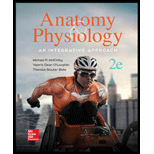
_____ 1. The cell body of a neuron does all of the following except
- a. release neurotransmitter into the synaptic cleft
- b. produce synaptic vesicles containing neurotransmitter that are subsequently transported to the synaptic knob.
- c. conduct graded potentials to the initial segment
- d. receive graded potentials from dendrites.
Introduction:
Neuron is a basic functional unit of the nervous system and is the specialized cells of the nervous system that makes a complex network for the transmission of messages. A neuron is made up of a cell body, nerve fibers: dendrites and an axon in its structure.
Answer to Problem 1DYKB
Correct answer:
The cell body of the neuron does not involve the released neurotransmitter into the synaptic cleft. Therefore, option a is correct.
Explanation of Solution
Reasons for the correct statements:
Option a. is given as “release neurotransmitter into the synaptic cleft”. Cell body does not involve in the production of neurotransmitter. The axon part of the cell body receives the graded potential which causes fusion of synaptic vesicle to the vesicle to the plasma membrane of the synaptic knob. This fusion results in the release of neurotransmitter from the synaptic vesicle. Hence, cell body does not cause the release of neurotransmitter into the synaptic cleft.
Hence, option a is correct.
Reasons for the incorrect statements:
Option b. is given as “produce synaptic vesicles containing neurotransmitter that is subsequently transported to the synaptic knob”. The cell body is involved in the synthesis of synaptic vesicles which contain neurotransmitter and these synaptic vesicles are ultimately transported to the synaptic knob through axon. Hence, option b. is incorrect.
Option c. is given as “conduct graded potentials to the initial segment”. The cell body involves the conduction of graded potential. Hence, option c. is incorrect.
Option d. is given as “receive graded potentials from dendrites”. The cell body receives the chemical potential from the dendrites. Hence, option d. is incorrect.
Hence, options b., c., and d. are incorrect.
The release of neurotransmitter into the synaptic cleft is not the function of the cell body.
Want to see more full solutions like this?
Chapter 12 Solutions
Anatomy & Physiology: An Integrative Approach
Additional Science Textbook Solutions
Campbell Biology (11th Edition)
Concepts of Genetics (12th Edition)
Microbiology: An Introduction
Campbell Biology: Concepts & Connections (9th Edition)
Laboratory Experiments in Microbiology (12th Edition) (What's New in Microbiology)
- Which of these do dendritic spines do?A. They synthesize proteins.B. They increase the surface area available for synapses.C. They hold the neuron in position.D. They metabolize fuels to provide energy for the rest of the neuron.arrow_forwardDamage to neurons from Alzheimer's disease may prevent neurons from receiving signals from other neurons. Which of the following structures of a neuron is first affected by the damage? Select one: a. Axon b. Cell Body c. Axon Terminal d. Dendritesarrow_forwardHeidi’s physician prescribed a medication that is known to block the reuptake of serotonin neurotransmitter from the synaptic cleft. This medication affects what segment in neuron transmission that is responsible for releasing the neurotransmitter? a. initial segment b. conductive segment c. transmissive segment d. receptive segmentarrow_forward
- When a neuron is inactive, more of which of the following exist OUTSIDE the neuron? A. Myelin sheaths B. Positive ions C. Neuropeptides D. Negative ionsarrow_forwardConsider the image. The neuron labeled number _____ in the figure is a motor neuron; its function is _____. A)2; stimulating muscles or glands B)3; stimulating muscles or glands C)1; connecting different types of neurons D)3; connecting different types of neuronsarrow_forwardWhy is that if A, B, and D neurons were all activated, an action potential in neuron C would not occur. But if A and D were activated, an action potential in C would occur?arrow_forward
- Many neurons have only a single axon, but many terminals at the end of the axon. How does this end structure of the axon support its function?arrow_forwardWhat part of the membrane composition of a neuron is most important for the permeability of the membrane to various ions? Group of answer choices a. The outside and inside are charged b. There are proteins embedded in the membrane c. There is myelin around some cells d. Its ability to exist in fluid enviornmentarrow_forwardA(n) ________ neuron has one axon and one dendrite extending directly from the cell body. a. unipolar b. bipolar c. multipolar d. pseudounipolararrow_forward
- Neurotransmitters must pass from an axon terminal to the next dendrite by crossing a fluid-filled space called the a. synapse. c. neuron. b. reuptake inhibitor. d. glial cell.arrow_forwardNeurotransmitters are released by_____ . a. axon terminals c. dendrites b. a neuron cell body d. glial cellsarrow_forwardTo which part or parts of a neuron does the all-or-none law apply? a. Axons b. Dendrites c. Both axons and dendritesarrow_forward
 Concepts of BiologyBiologyISBN:9781938168116Author:Samantha Fowler, Rebecca Roush, James WisePublisher:OpenStax College
Concepts of BiologyBiologyISBN:9781938168116Author:Samantha Fowler, Rebecca Roush, James WisePublisher:OpenStax College

